Abstract
The binding of 125I-lipoprotein (a) [Lp(a)] to cell surface receptors was studied on cultured human fibroblasts. The results were compared with corresponding data obtained with 125I-low density lipoproteins (LDL). Equilibrium binding studies showed that Lp(a) is bound with high affinity by the cell surface receptors. The maximum binding capacity for Lp(a) was 37% lower than for LDL. For Lp(a) and LDL, the Scatchard plots displayed linearity, indicating a single category of binding sites. Half-maximal saturation occurred at a concentration of 9.52 +/- 1.04 nM for Lp(a) and 7.76 +/- 1.29 nM for LDL. Competition binding experiments revealed that Lp(a) and LDL are nearly equally potent in competing each other for the binding sites. Binding of Lp(a) and LDL were followed by suppression of 3-hydroxy-3-methylglutaryl coenzyme A reductase activity. Cyclohexanedione treatment of Lp(a) and LDL completely abolished receptor binding. Neither Lp(a) nor LDL were specifically bound by fibroblasts obtained from a patient with homozygous familial hypercholesterolemia (FH). The removal mechanisms for Lp(a) and LDL were further compared by in vivo studies. Radioiodinated Lp(a) and LDL were injected intravenously into 12 normolipemic individuals to measure kinetic parameters of these two lipoproteins simultaneously in each subject. Mean fractional catabolic rate (FCR) of Lp(a) was 0.260 +/- 0.060 and mean FCR of LDL was 0.377 +/- 0.077 (mean +/- SD). In each subject, FCR of Lp(a) was lower than the FCR of LDL; the mean difference was 31%. The absolute synthetic rate of Lp(a) was significantly lower than the corresponding value of LDL. In each individual, the percentage of total Lp(a) that was contained in the intravascular space was higher than the corresponding value of LDL; the mean difference was 19%. A highly significant positive correlation was found between FCR of LDL and FCR of Lp(a) (r = 0.853, P less than 0.01). No relationship was found between the serum concentration of LDL-apolipoprotein B and Lp(a). The serum level of Lp(a) was positively related to the absolute rate of Lp(a) synthesis (r = 0.979, P less than 0.01). The serum level of LDL-apolipoprotein B was inversely related to FCR of LDL (r = 0.613, P less than 0.05). In a patient with homozygous FH, FCR of LDL was 0.205 and FCR of Lp(a) was 0.210. The results of these studies show that Lp(a) is specifically bound with high affinity to the same receptors of human fibroblasts as LDL. The affinity and maximum binding capacity are slightly lower for Lp(a) than for LDL. The results of the turnover studies are consistent with the assumption that Lp(a) is removed from the plasma by similar mechanisms as LDL.
Full text
PDF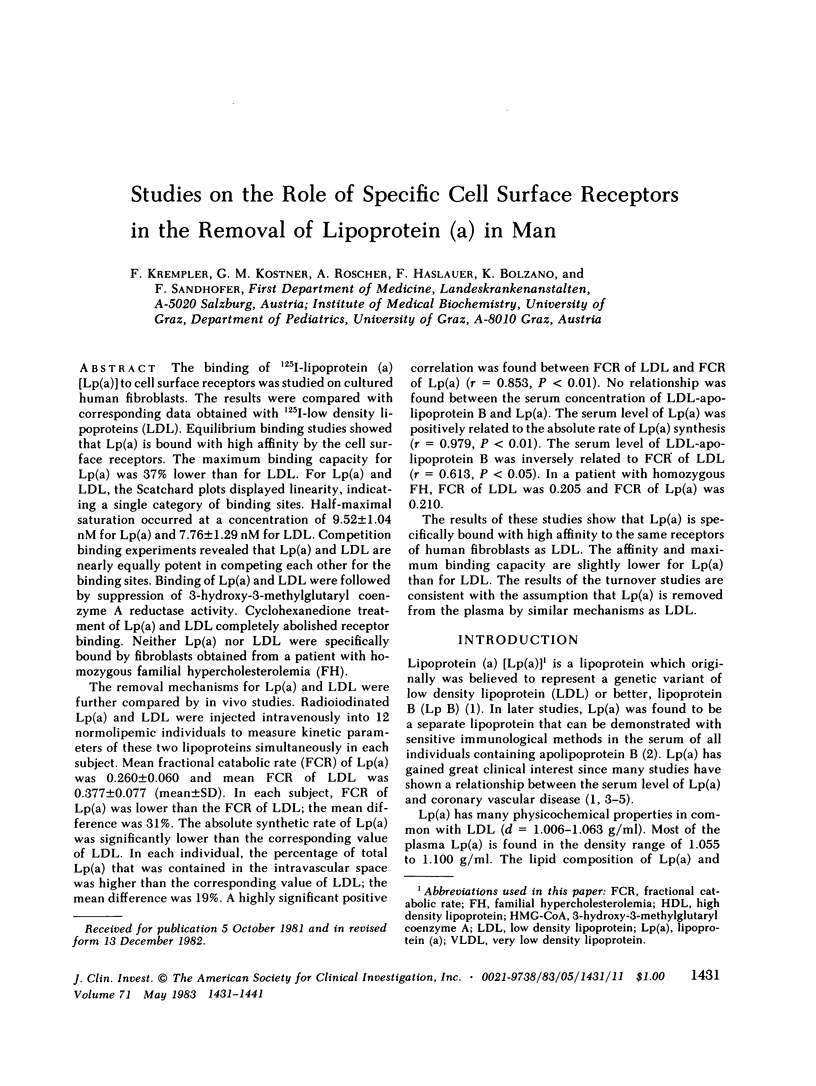
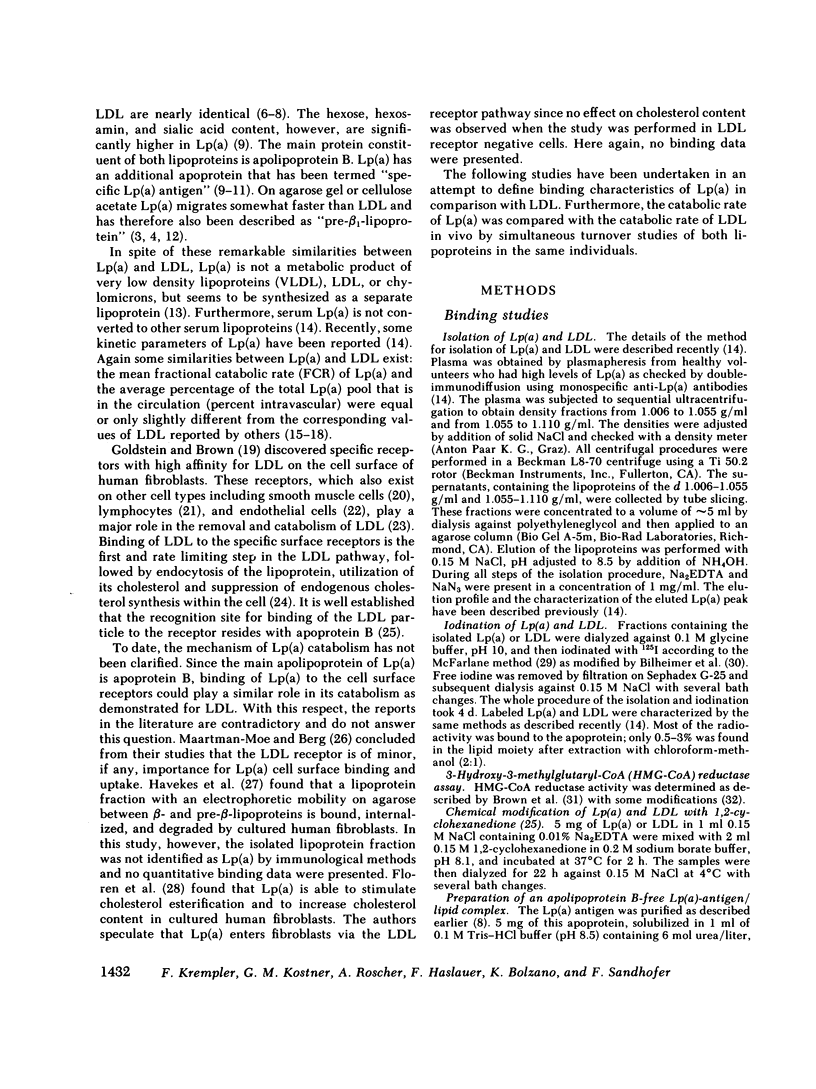


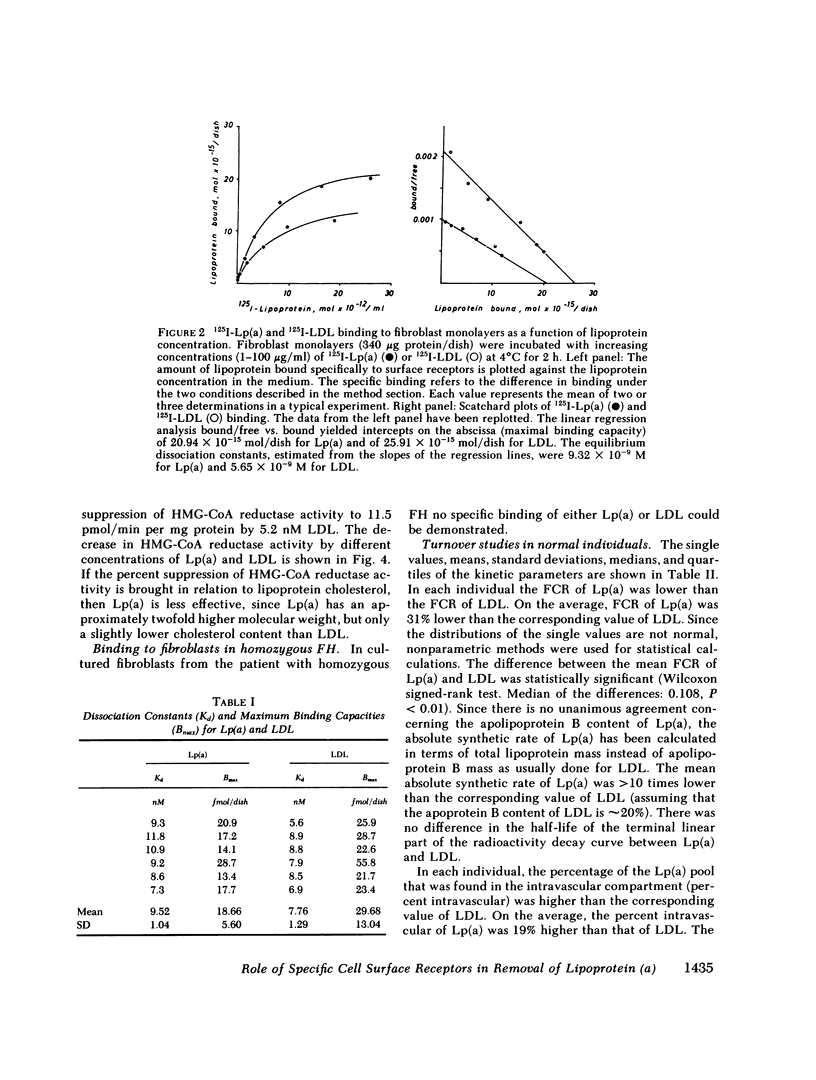

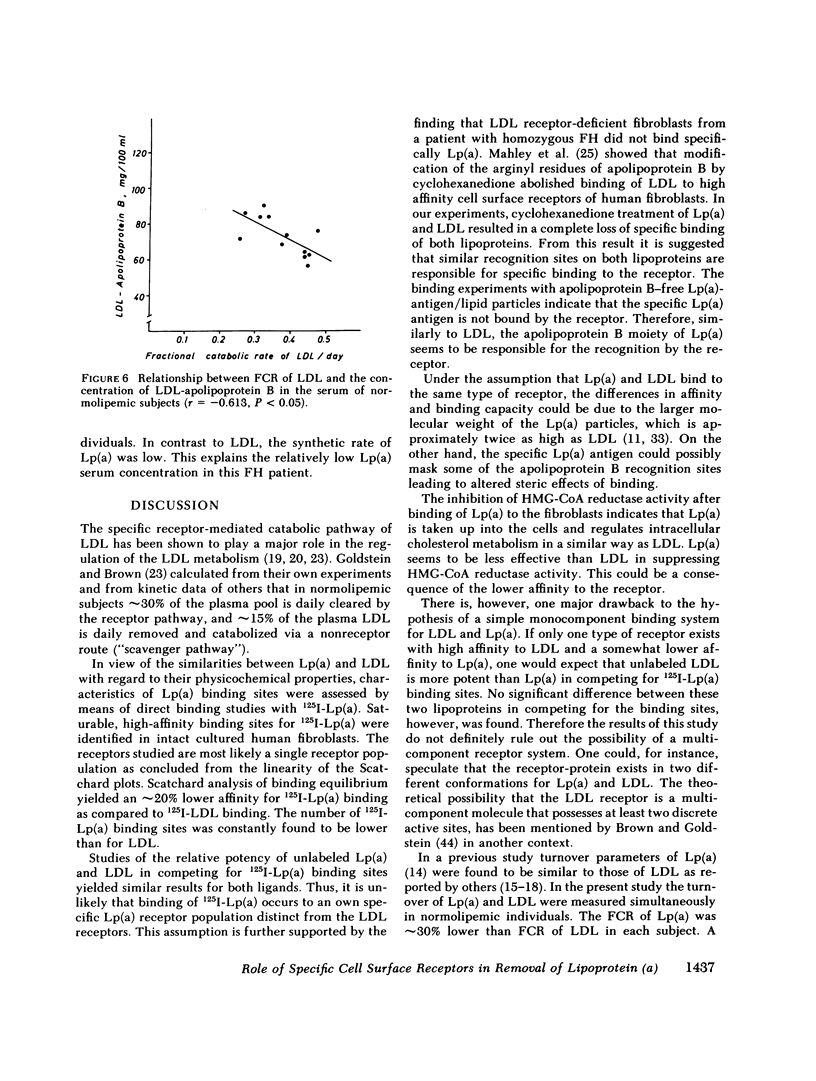



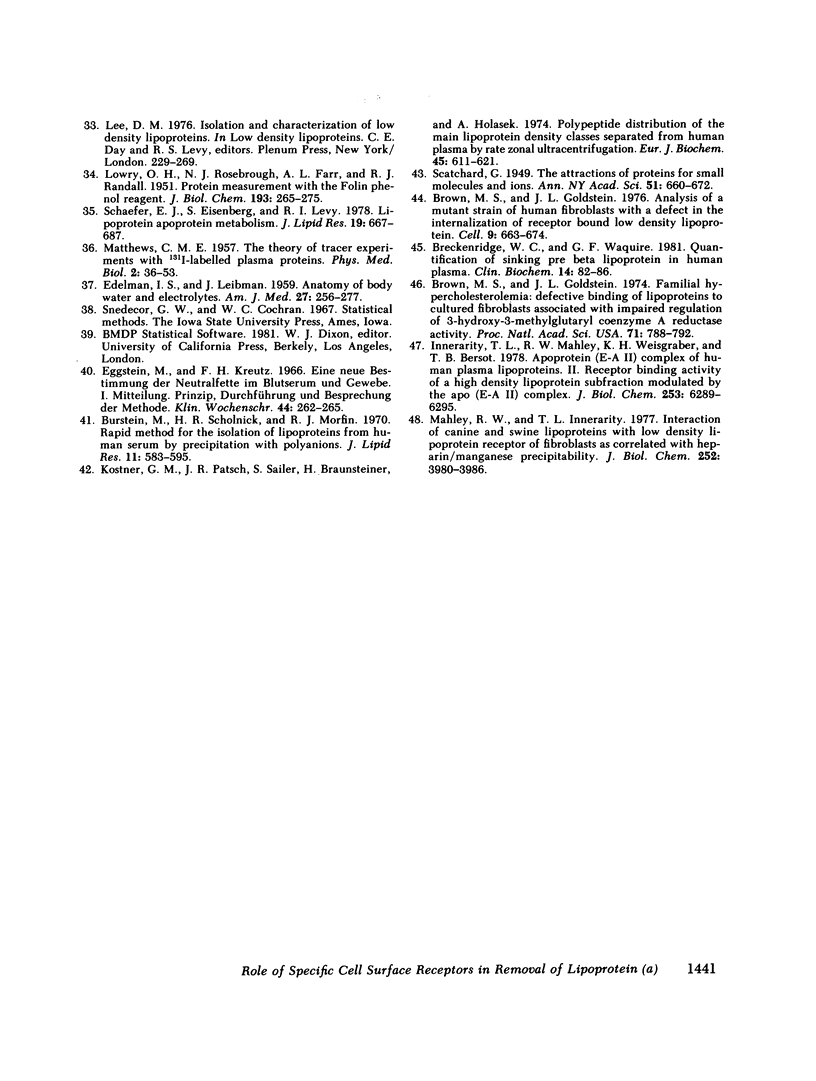
Selected References
These references are in PubMed. This may not be the complete list of references from this article.
- Albers J. J., Adolphson J. L., Hazzard W. R. Radioimmunoassay of human plasma Lp(a) lipoprotein. J Lipid Res. 1977 May;18(3):331–338. [PubMed] [Google Scholar]
- Albers J. J., Cabana V. G., Warnick G. R., Hazzard W. R. Lp(a) lipoprotein: relationship to sinking pre-beta lipoprotein hyperlipoproteinemia, and apolipoprotein B. Metabolism. 1975 Sep;24(9):1047–1054. doi: 10.1016/0026-0495(75)90098-0. [DOI] [PubMed] [Google Scholar]
- BERG K. A NEW SERUM TYPE SYSTEM IN MAN--THE LP SYSTEM. Acta Pathol Microbiol Scand. 1963;59:369–382. doi: 10.1111/j.1699-0463.1963.tb01808.x. [DOI] [PubMed] [Google Scholar]
- Berg K., Dahlén G., Frick M. H. Lp(a) lipoprotein and pre-beta1-lipoprotein in patients with coronary heart disease. Clin Genet. 1974;6(3):230–235. doi: 10.1111/j.1399-0004.1974.tb00657.x. [DOI] [PubMed] [Google Scholar]
- Bilheimer D. W., Eisenberg S., Levy R. I. The metabolism of very low density lipoprotein proteins. I. Preliminary in vitro and in vivo observations. Biochim Biophys Acta. 1972 Feb 21;260(2):212–221. doi: 10.1016/0005-2760(72)90034-3. [DOI] [PubMed] [Google Scholar]
- Breckenridge W. C., Maquire G. F. Quantification of sinking pre beta lipoprotein in human plasma. Clin Biochem. 1981 Apr;14(2):82–86. doi: 10.1016/s0009-9120(81)90755-4. [DOI] [PubMed] [Google Scholar]
- Brown M. S., Dana S. E., Goldstein J. L. Regulation of 3-hydroxy-3-methylglutaryl coenzyme A reductase activity in human fibroblasts by lipoproteins. Proc Natl Acad Sci U S A. 1973 Jul;70(7):2162–2166. doi: 10.1073/pnas.70.7.2162. [DOI] [PMC free article] [PubMed] [Google Scholar]
- Brown M. S., Goldstein J. L. Analysis of a mutant strain of human fibroblasts with a defect in the internalization of receptor-bound low density lipoprotein. Cell. 1976 Dec;9(4 Pt 2):663–674. doi: 10.1016/0092-8674(76)90130-6. [DOI] [PubMed] [Google Scholar]
- Brown M. S., Goldstein J. L. Familial hypercholesterolemia: defective binding of lipoproteins to cultured fibroblasts associated with impaired regulation of 3-hydroxy-3-methylglutaryl coenzyme A reductase activity. Proc Natl Acad Sci U S A. 1974 Mar;71(3):788–792. doi: 10.1073/pnas.71.3.788. [DOI] [PMC free article] [PubMed] [Google Scholar]
- Burstein M., Scholnick H. R., Morfin R. Rapid method for the isolation of lipoproteins from human serum by precipitation with polyanions. J Lipid Res. 1970 Nov;11(6):583–595. [PubMed] [Google Scholar]
- Dahlén G., Berg K., Ramberg U. B., Tamm A. Lp(a) lipoprotein and pre-beta1-lipoprotein in young adults. Acta Med Scand. 1974 Oct;196(4):327–331. doi: 10.1111/j.0954-6820.1974.tb01018.x. [DOI] [PubMed] [Google Scholar]
- Dahlén G., Ericson C., Furberg C., Lundkvist L., Svärdsudd K. Studies on an extra pre-beta lipoprotein fraction. Acta Med Scand Suppl. 1972;531:1–29. [PubMed] [Google Scholar]
- EDELMAN I. S., LEIBMAN J. Anatomy of body water and electrolytes. Am J Med. 1959 Aug;27:256–277. doi: 10.1016/0002-9343(59)90346-8. [DOI] [PubMed] [Google Scholar]
- Eggstein M., Kreutz F. H. Eine neue Bestimmung der Neutralfette im Blutserum und Gewebe. I. Prinzip, Durchführung und Besprechung der Methode. Klin Wochenschr. 1966 Mar 1;44(5):262–267. doi: 10.1007/BF01747716. [DOI] [PubMed] [Google Scholar]
- Ehnholm C., Garoff H., Renkonen O., Simons K. Protein and carbohydrate composition of Lp(a)lipoprotein from human plasma. Biochemistry. 1972 Aug 15;11(17):3229–3232. doi: 10.1021/bi00767a015. [DOI] [PubMed] [Google Scholar]
- Floren C. H., Albers J. J., Bierman E. L. Uptake of Lp (a) lipoprotein by cultured fibroblasts. Biochem Biophys Res Commun. 1981 Sep 30;102(2):636–639. doi: 10.1016/s0006-291x(81)80179-9. [DOI] [PubMed] [Google Scholar]
- Gianturco S. H., Gotto A. M., Jr, Jackson R. L., Patsch J. R., Sybers H. D., Taunton O. D., Yeshurun D. L., Smith L. C. Control of 3-hydroxy-3-methylglutaryl-CoA reductase activity in cultured human fibroblasts by very low density lipoproteins of subjects with hypertriglyceridemia. J Clin Invest. 1978 Feb;61(2):320–328. doi: 10.1172/JCI108942. [DOI] [PMC free article] [PubMed] [Google Scholar]
- Goldstein J. L., Brown M. S. Atherosclerosis: the low-density lipoprotein receptor hypothesis. Metabolism. 1977 Nov;26(11):1257–1275. doi: 10.1016/0026-0495(77)90119-6. [DOI] [PubMed] [Google Scholar]
- Goldstein J. L., Brown M. S. Binding and degradation of low density lipoproteins by cultured human fibroblasts. Comparison of cells from a normal subject and from a patient with homozygous familial hypercholesterolemia. J Biol Chem. 1974 Aug 25;249(16):5153–5162. [PubMed] [Google Scholar]
- Goldstein J. L., Brown M. S. Lipoprotein receptors, cholesterol metabolism, and atherosclerosis. Arch Pathol. 1975 Apr;99(4):181–184. [PubMed] [Google Scholar]
- Goldstein J. L., Brown M. S. The low-density lipoprotein pathway and its relation to atherosclerosis. Annu Rev Biochem. 1977;46:897–930. doi: 10.1146/annurev.bi.46.070177.004341. [DOI] [PubMed] [Google Scholar]
- Havekes L., Vermeer B. J., Brugman T., Emeis J. Binding of LP(a) to the low density lipoprotein receptor of human fibroblasts. FEBS Lett. 1981 Sep 28;132(2):169–173. doi: 10.1016/0014-5793(81)81153-2. [DOI] [PubMed] [Google Scholar]
- Ho Y. K., Brown S., Bilheimer D. W., Goldstein J. L. Regulation of low density lipoprotein receptor activity in freshly isolated human lymphocytes. J Clin Invest. 1976 Dec;58(6):1465–1474. doi: 10.1172/JCI108603. [DOI] [PMC free article] [PubMed] [Google Scholar]
- Innerarity T. L., Mahley R. W., Weisgraber K. H., Bersot T. P. Apoprotein (E--A-II) complex of human plasma lipoproteins. II. Receptor binding activity of a high density lipoprotein subfraction modulated by the apo(E--A-II) complex. J Biol Chem. 1978 Sep 10;253(17):6289–6295. [PubMed] [Google Scholar]
- Kostner G. M., Patsch J. R., Sailer S., Braunsteiner H., Holasek A. Polypeptide distribution of the main lipoprotein density classes separated from human plasma by rate zonal ultracentrifugation. Eur J Biochem. 1974 Jun 15;45(2):611–621. doi: 10.1111/j.1432-1033.1974.tb03587.x. [DOI] [PubMed] [Google Scholar]
- Krempler F., Kostner G. M., Bolzano K., Sandhofer F. Turnover of lipoprotein (a) in man. J Clin Invest. 1980 Jun;65(6):1483–1490. doi: 10.1172/JCI109813. [DOI] [PMC free article] [PubMed] [Google Scholar]
- Krempler F., Kostner G., Bolzano K., Sandhofer F. Lipoprotein (a) is not a metabolic product of other lipoproteins containing apolipoprotein B. Biochim Biophys Acta. 1979 Oct 26;575(1):63–70. doi: 10.1016/0005-2760(79)90131-0. [DOI] [PubMed] [Google Scholar]
- LOWRY O. H., ROSEBROUGH N. J., FARR A. L., RANDALL R. J. Protein measurement with the Folin phenol reagent. J Biol Chem. 1951 Nov;193(1):265–275. [PubMed] [Google Scholar]
- Langer T., Strober W., Levy R. I. The metabolism of low density lipoprotein in familial type II hyperlipoproteinemia. J Clin Invest. 1972 Jun;51(6):1528–1536. doi: 10.1172/JCI106949. [DOI] [PMC free article] [PubMed] [Google Scholar]
- MATTHEWS C. M. The theory of tracer experiments with 131I-labelled plasma proteins. Phys Med Biol. 1957 Jul;2(1):36–53. doi: 10.1088/0031-9155/2/1/305. [DOI] [PubMed] [Google Scholar]
- Maartmann-Moe K., Berg K. Lp(a) lipoprotein enters cultured fibroblasts independently of the plasma membrane low density lipoprotein receptor. Clin Genet. 1981 Nov;20(5):352–362. doi: 10.1111/j.1399-0004.1981.tb01047.x. [DOI] [PubMed] [Google Scholar]
- Mahley R. W., Innerarity T. L. Interaction of canine and swine lipoproteins with the low density lipoprotein receptor of fibroblasts as correlated with heparin/manganese precipitability. J Biol Chem. 1977 Jun 10;252(11):3980–3986. [PubMed] [Google Scholar]
- Mahley R. W., Innerarity T. L., Pitas R. E., Weisgraber K. H., Brown J. H., Gross E. Inhibition of lipoprotein binding to cell surface receptors of fibroblasts following selective modification of arginyl residues in arginine-rich and B apoproteins. J Biol Chem. 1977 Oct 25;252(20):7279–7287. [PubMed] [Google Scholar]
- Packard C. J., Third J. L., Shepherd J., Lorimer A. R., Morgan H. G., Lawrie T. D. Low density lipoprotein metabolism in a family of familial hypercholesterolemic patients. Metabolism. 1976 Sep;25(9):995–1006. doi: 10.1016/0026-0495(76)90129-3. [DOI] [PubMed] [Google Scholar]
- Schaefer E. J., Eisenberg S., Levy R. I. Lipoprotein apoprotein metabolism. J Lipid Res. 1978 Aug;19(6):667–687. [PubMed] [Google Scholar]
- Sigurdsson G., Nicoll A., Lewis B. The metabolism of low density lipoprotein in endogenous hypertriglyceridaemia. Eur J Clin Invest. 1976 Mar 31;6(2):151–158. doi: 10.1111/j.1365-2362.1976.tb00506.x. [DOI] [PubMed] [Google Scholar]
- Simons K., Ehnholm C., Renkonen O., Bloth B. Characterization of the Lp(a) lipoprotein in human plasma. Acta Pathol Microbiol Scand B Microbiol Immunol. 1970;78(4):459–466. doi: 10.1111/j.1699-0463.1970.tb04328.x. [DOI] [PubMed] [Google Scholar]
- Simons L. A., Reichl D., Myant N. B., Mancini M. The metabolism of the apoprotein of plasma low density lipoprotein in familial hyperbetalipoproteinaemia in the homozygous form. Atherosclerosis. 1975 Mar-Apr;21(2):283–298. doi: 10.1016/0021-9150(75)90087-8. [DOI] [PubMed] [Google Scholar]
- Stein O., Stein Y. High density lipoproteins reduce the uptake of low density lipoproteins by human endothelial cells in culture. Biochim Biophys Acta. 1976 May 27;431(2):363–368. doi: 10.1016/0005-2760(76)90157-0. [DOI] [PubMed] [Google Scholar]
- Utermann G., Lipp K., Wiegandt H. Studies on the Lp(a)-lipoprotein of human serum. IV. The disaggregation of the Lp(a)-lipoprotein. Humangenetik. 1972;14(2):142–150. doi: 10.1007/BF00273299. [DOI] [PubMed] [Google Scholar]
- Vogleberg K. H., Utermann G., Gries F. A. Zur Differenzierurg des Lp(a)-Lipoproteins mit Hilfe der Agarosegel-Elektrophorese. Z Klin Chem Klin Biochem. 1973 Jul;11(7):291–296. [PubMed] [Google Scholar]


